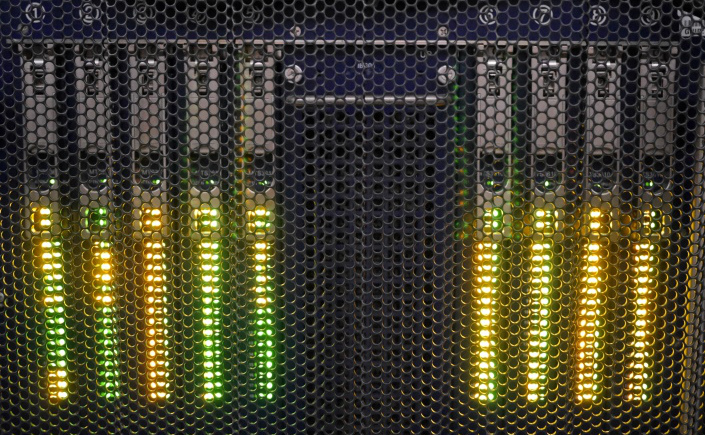
Mesabi’s high-speed network switch, pictured here, allows for ultra-fast communication and data transfer among supercomputing nodes.
The University of Minnesota is boosting its research infrastructure with a mountain of computing power.
Supercomputer Mesabi recently became the newest addition to the Minnesota Supercomputing Institute. Sporting a name that shares the Ojibwe word for “immense mountain,” Mesabi is projected to be among the five fastest supercomputers used for academic purposes in the country. Its computing capabilities will drive U of M research forward and open up new possibilities in a wide range of academic fields.
“Researchers rely on high-performance computing to advance and support their research,” said Claudia Neuhauser, Ph.D, director of the U’s Informatics Institute and interim director of MSI. “Mesabi will provide the power required to handle more complex and massive scientific data sets than any of our other supercomputers, allowing researchers to forge ahead with their data and make new discoveries.”
Preparations for Mesabi began in 2013, when a committee of university faculty and IT leaders set out to define what the U needed in a new, world-class supercomputer. It selected a model built by Hewlett-Packard, chocked full of top-of-the-line hardware: a high-end Intel processor, a low-latency Mellanox network and the latest NVidia graphics. The storage system, built by Panasas, has an enormous 2.4 petabytes capacity and the ability to read and write data at blazingly fast speeds, allowing U researchers to address a growing number of data-intensive research questions. Given its colossal resources, “Mesabi” is a fitting name for the supercomputer, and carries on MSI’s tradition of naming its supercomputers after the state’s natural resources. The Mesabi Range is the largest iron ore deposit in northeastern Minnesota’s Iron Range.
Mesabi will add to MSI’s portfolio of high end supercomputing resources, extending the total number of research projects the institute can support at once and increasing its capacity to handle exceptionally complex research operations. Mesabi works 3,864 times faster than a typical personal computer, and has about 8,700 times the memory. Its new hardware will also add 1 petabyte to the storage MSI already has available — that is, roughly 2,000 times what an average personal computer can hold.
These features make the supercomputer especially well-suited for genetics research, which requires the juggling and processing of large quantities of DNA information. For researchers Timothy Starr, Ph.D., assistant professor of obstetrics, gynecology and women’s health, and David Largaespada, professor of genetics, cell biology and development with the U’s Masonic Cancer Center, Mesabi’s capabilities means they can use leading sequencing technologies that require enormous computing power. With the supercomputer’s help, the researchers will be able to spot variations in a person’s genetic code that may contribute to the formation of cancer, and ultimately use this knowledge to develop personalized cancer treatments that are more effective than traditional treatments.
There are many applications that extend beyond genetics, too, from modeling how air flows over an aircraft at hypersonic speeds to generating high-resolution satellite maps of polar regions. Tom Jones, Ph.D., professor with the Minnesota Institute for Astrophysics at the U, intends to use the supercomputer to explore the physics of the universe. Using its high speed processors, Jones and his team can run a complex simulation program to model how systems of stars, planets and other objects function. The program will help explain the forces behind gravity and electrically charged gases in deep space, which can help shed light on how the early universe developed.
Aided by its newest addition, MSI’s family of supercomputers will continue to attract research funding for the U, provide researchers the tools needed to make scientific breakthroughs and contribute to findings that benefit society through the advancement of knowledge. And the capabilities of Mesabi will extend beyond the university — MSI also offers a number of resources and services for companies that need to process especially large data sets to accelerate their research, but do not already have the equipment needed to do so.
Welcoming Mesabi to the MSI family
The Minnesota Supercomputing Institute will celebrate Mesabi’s completion with a dedication ceremony following its 2015 Research Exhibition. As part of the event, MSI staff will take visitors on a tour to see Mesabi and learn about its capabilities.
If you would like to attend, please let MSI know. The event will be held from 3:30 to 6 p.m. on Thursday, April 23, 2015, on Walter Library’s 4th floor. Contact pr@msi.umn.edu with any questions.